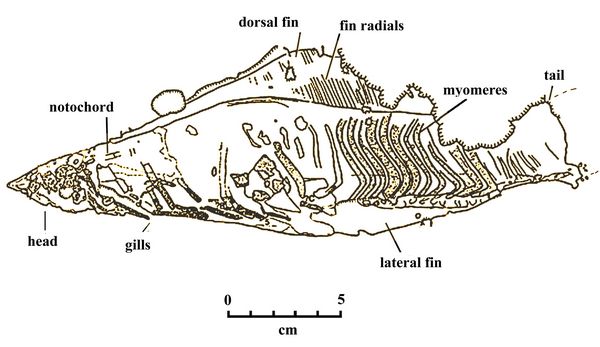Athena Review Image Archive ™
Myllokunmingia fengjiaoa

Myllokunmingia fengjiaoa (after Shu et al. 2003)
Myllokunmingia fengjiaoa is an early chordate from the Early Cambrian period from Yunnan Province in southern China. It was found by Shu et al. (2003) near Kunming City (for which it is named), in fine-grained Maotianshan shales at Erciacun in the Yuanshan member of the Qiongzhusi Formation, near Haikou. It belongs to the phylum Chordata, the clade Craniata, and the family myllokunmingiidae.
M. fengjiaoa is among the oldest possible craniates, found in the lower Cambrian Chengjiang phase (524 million years ago). The single specimen (ELI-0000201) is well preserved, with the tip of the tail buried in sediment. It appears to have a skull and skeletal structures made of cartilage. The body length is 28 mm and body height 6 mm. It has a distinct head and trunk with a forward sail-like (1.5 mm) dorsal fin and a ventral fin fold (probably paired).
M. fengjiaoa has 25 segments (myomeres) with rearward chevrons in the trunk. There is a notochord, a pharynx, and a digestive tract. While the mouth cannot be clearly identified, there may be a pericardic cavity. The head has five or six gill pouches with hemibranchs.
M. fengjiaoa is related to several other Cambian chordates found in the Maotianshan shales, including Haikouichthys and Zhongjianichthys.
References
Shu, D-G., Luo, H-L., Conway Morris, S., Zhang, X-L., Hu, S-X, Chen, L., Han, J., Zhu, M. et al. 1999. Nature 402
Copyright © 1996-2020 Rust Family Foundation (All Rights Reserved).